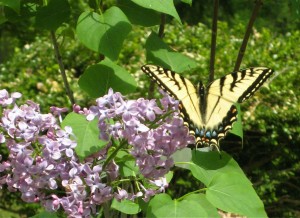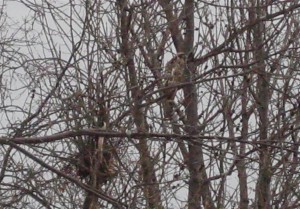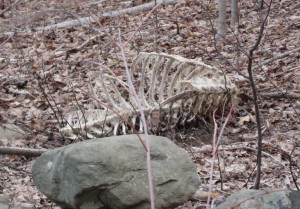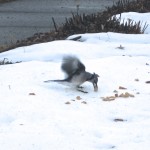
I love this time of year, the end of winter, the first signs of spring. The birds are fast returning. We have bluebirds checking out the nesting boxes. The geese have been flying south, their travels etched across the sky in long arching Vs. We’ve noticed that the vultures are back too. Where they go during the coldest months I have no idea, but they are noticeably absent in the dead of winter. The daffodils are poking through the ground. The first chickweed is growing close to the house where we get the most sun. The deer that have overnighted in the woods at the back of the house all winter have moved on. We’ve sighted our neighborhood foxes, ready to start the mating process again. We expect to soon see baby foxes playing about as we do every year. And we’ve smelled skunk, a sure sign of spring!
In the dead of winter I began laying out bread crumbs for the birds, only occasionally. I didn’t want to start a new habit after spending so much time breaking myself of the old habits of a lifetime. I noticed that the crows were always the first to arrive. They’d take what they wanted and then the jays would arrive for second pickings. After that, the brave little juncos came and so on down the line. After about an hour there was generally nothing left.
I started to hear the crows calling at about 6:30 every morning, sometimes earlier. “Where’s our bread, Jan!” they seemed to be saying. “We’re hungry!” And so a little guilt crept in; now I felt I had to feed them. I knew our yard was only one stop on their daily rounds through the neighborhood, but I saw that they liked punctuality and that they actually depended on the meagre crumbs I put out. It was exactly what I was trying to avoid—being predictable. But these sentinels of nature, ever watchful, would not let me be so aimless and irresponsible. And so they call me out each morning, very loudly commanding that I contribute to their welfare, that I meet their demands.
We don’t actually eat much bread, so on days when none is available I scrounge through the fridge and pantry looking for something that might appeal. I refuse to buy commercial birdseed, with its chemicals and corporate intent. I believe in recycling. The other day I put out some sweet potato fries. “Thumbs up!” the birds said. “YUM!” Then I put out some stale tortilla chips. “Thumbs down. YUCK!” they said, and the pile of yellow corn chips lies there still. I’m sure that the Jehovah’s Witness who stopped by the other day and stuck a flyer in the door wondered just what that pile of chips—organic too—was doing there!
My observations of nature during winter lead me to write this blog today. I’ve noticed how beneath the snow there is vibrant life, energy gathering for the moment of emergence. When the time is right, the tulips and daffodils poke through the frozen ground, the wild onions pop up, and the first wild garlic-mustard turns toward the morning light. I was thrilled the other day to see just these signs of life as the snow finally melted in our yard. It got me to thinking about us, how the human condition is much like nature.
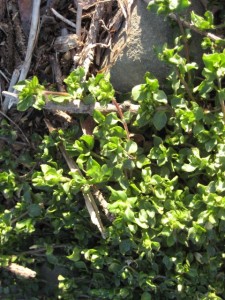
We too have lots of things inside us struggling to emerge, secrets waiting to reveal themselves, beauty waiting to blossom, desires waiting to be lived, repressed memories waiting for the right moment to be known. We too hold back until the time is right. Can I dare to be the person I truly am? Must I wait another season before I finally give myself permission to do this or that? How long can I hold back that which is stirring inside me?
Nature doesn’t think. Nature acts. Nature doesn’t hold back. Nature is in constant flux and change. Nature is constantly transforming even when we think it’s dead, in the dead of winter, frozen and covered in snow. So is our physical body like nature, constantly changing and transforming. Our cells slough off and regrow, our organs totally regenerate every few years, some quicker than that. We aren’t even aware of how like nature our bodies are. Without thought we are like the seasons.
There’s another part of us that lies inside the physical body, our spirit, and even deeper than that lies our soul. Inside this vehicle we call our body these two parts of who we truly are, our ancient reincarnated selves, lie waiting. More deeply hidden from our awareness than even the mysterious workings of our physical bodies, these parts go along with us as we face the world each day and go about our lives. But these are the parts of us that are like the crows calling, asking us to attend to them, urging us to become predictable and reliable sources of nurturance. “Wake up and feed us!” they say. These are the parts that lie below the frozen surface and wait for the warmth of spring. These are the parts that when we are ready will pop up and take us forward on new journeys of transformation and change, in both our inner and our outer world.
In recapitulation, these are the parts that emerge alongside our memories. These are the parts that lead us down the paths of memory and retrieval of self. These are the parts that teach us that we are all the same, that we are all beings of love and compassion. These are the parts that at some point in our spiritual evolution must become the most important aspects of being human. When we are ready we will know them more fully. When we are ready our own springtime will arrive. Until then, I suggest tossing a few morsels of sustenance, a few hellos, a few nods of recognition. “I know you’re there, I’ll be back someday soon.”
It’s okay to wait, but be aware that until the time is right for these parts to emerge and inform us of what we must learn about ourselves, preparations are underway. We may already have received many knocks at the door, asking us to venture deeper into our physical bodies and discover what’s there. We may have already been invited deep inside, gone down to our roots. We may have already gotten to our core issues and our core reasons for living this life we live now. We may have already done a recapitulation or be in the midst of doing it.
The real key to being human is that we are not really like nature at all. We have the ability to think, to reason, and to explore our inner world. We have parts inside us asking us to work with them, to make something happen that will transform us. We have free will, the freedom to learn how to enact our own transformation so we can be different, so we can live our lives in a new unpredictable way, yet fully in alignment with our true spirit and soul nature.

And so, even if it may appear to be quite impossible that we could ever change our circumstances, we really do have the ability to choose how we want to live. We can choose to live as if it were springtime all the time. In fact, I believe this is what our spirit and our soul ask of us, to always be connected to them, to know them in the deepest way.
They ask us to not forget that they are what make us who we are, make us human, for they are the energy behind our human physical body. They ask us to be aware when the snows come, to be ready to thaw the ground and let our flowers blossom in spite of it. They are like the crows calling us to responsible tenure, to attend to these most important aspects of our human condition. It is here, in our spirit and soul selves being allowed to live, that we will truly evolve.
We will know when the time is right to answer the knocks on the door, either in this lifetime or another, but eventually we will all have to answer. We will all have to feed the crows of recapitulation, the spirit connectors that come asking us if we are ready yet.
Today the crows got bread! And my spirit and soul? They got to express themselves in this blog.
From the heart and soul of me, I wish you well,
Jan

